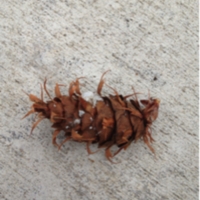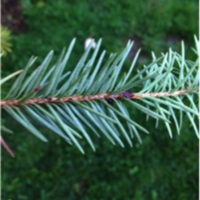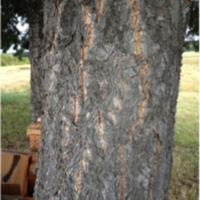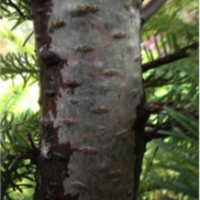Douglas Fir : Description and Identification
Douglas-firs are big trees. In fact, they are the second tallest on the planet, losing to Coast Redwood (Sequoia sempervirens) by ~50ft. If grown in the optimal conditions, deep, well-drained clayish soils, they can grow to 320ft, although this is rare. The Douglas-fir is a fairly simple tree to identify. The secret? Mouse butts. If it is your wish to find a Douglas-fir, just follow these simple steps:
1. Go to one of the afore-mentioned places where the tree grows. (Or just look in the southeast corner, or the north end of the UVM Green)
2. As you look around, eliminate all those trees without needles
3. Next – and if you want to avoid the entire dichotomous key process, this is an important step – walk up to each tree and find a cone. In a natural setting, there should be plenty on the ground around the base; on the Green, I had to climb the tree to find a good one. If you can’t find a cone for any tree you are looking at, it probably isn’t a Doug fir.
4. Once you have a cone from each tree, lay them down and look for one that has mouse butts sticking out of it. Countless tree ID books and keys will describe them as “three pronged brackets” or “three pointed bracts”, they are wrong: mouse butts. (See Myths)
5. Now that you have seen it once, the cone is quite memorable and should make finding a Doug fir fairly easy. Discarding the rest of the cones, walk back to the tree your mouse butts originated from.
6. Take another look at the tree and you will find all the characteristics the dichotomous key would have described to you:
a. Short (.75”-1.25”) needles, singly attached to the branch
i. Each needle will have two white stripes on the underside called stomatal bands
ii. Needles are flat and cannot be rolled between fingers easily
iii. Although entitled “Douglas-fir”, the tree is not truly a fir and the needles will be a little prickly, but not as sharp as a Colorado blue spruce
b. The cone itself will be 3”-5” in length and 1”-2” wide.
c. Mostly smooth, greyish-brown bark on young trees, older trees will have thick, reddish brown bark with furrows.
d. If you take a step back, Doug firs are generally conical or spire shaped. In young trees the lower branches touch the ground, in older ones, the lowest branch might be 10-20 meters off the ground. In old-growth forests you might find the lowest branch 40 meters up.
Congratulations! You now know what a Douglas-fir looks like and how to distinguish it from other conifers.




